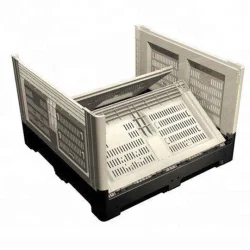Choosing the Right Industrial Plastic Containers for Your Business
2024-09-14
Selecting the right industrial plastic containers for your business is crucial to maintaining an efficient operation. With so many different types, materials, and designs available, it’s essential to choose the right container that fits your specific needs. In this blog, we’ll guide you through the key factors to consider when selecting plastic containers for industrial use, helping you make informed decisions that enhance your productivity and reduce costs.
1. Consider the Container’s Purpose
Before choosing a plastic container, it’s essential to define its intended use. Different industries and applications have varying requirements for containers, such as durability, weight capacity, or material resistance.
Key Questions:
- Storage or Transport? Will the container be used primarily for storing items in a static location, or will it be used to transport materials between locations?
- Handling Conditions? Consider the environment in which the container will be used. Will it be exposed to extreme temperatures, chemicals, or heavy machinery?
- Weight Capacity? Make sure the container can handle the weight of the materials or products that will be stored or transported.
2. Choose the Right Material
Industrial plastic containers come in a variety of materials, each with unique properties that suit different applications. Some common materials used for these containers include:
2.1. Polyethylene (PE)
Polyethylene is one of the most widely used materials for plastic containers due to its durability, flexibility, and chemical resistance. It’s ideal for general-purpose storage and transportation needs.
Advantages:
- Flexible and durable: Suitable for long-term use in various environments.
- Chemical resistance: PE containers are resistant to chemicals, acids, and oils.
2.2. Polypropylene (PP)
Polypropylene offers excellent strength and resistance to higher temperatures, making it ideal for containers used in demanding industrial settings.
Advantages:
- Heat resistance: Suitable for environments where containers are exposed to higher temperatures.
- Toughness: PP containers can handle heavy loads and rough handling.
2.3. High-Density Polyethylene (HDPE)
HDPE is known for its excellent strength-to-density ratio, offering superior durability and impact resistance. It’s often used for heavy-duty containers that need to withstand significant wear and tear.
Advantages:
- Impact resistance: Ideal for applications where containers are subjected to heavy handling or impacts.
- Long-lasting: HDPE containers have a longer lifespan, reducing the need for replacements.
3. Size and Design Considerations
Plastic containers come in a wide range of sizes, shapes, and designs to meet different operational requirements. Selecting the right size and design can improve efficiency, save space, and reduce costs.
3.1. Stackability
Stackable containers help save valuable storage space in warehouses and transportation vehicles. Containers designed for stacking often come with reinforced edges to ensure they remain stable even when loaded.
Benefits:
- Space efficiency: Maximize vertical storage space, reducing the need for additional storage areas.
- Improved organization: Stackable containers can help maintain a clean, organized workspace.
3.2. Collapsible Containers
For industries where space is at a premium, collapsible plastic containers offer a convenient solution. These containers can be folded when not in use, saving storage space and reducing transportation costs.
Benefits:
- Space-saving: Collapsible containers take up less room when stored or shipped empty.
- Lower transportation costs: Reduced volume means lower costs for returning empty containers.
4. Special Features and Customization
Many industrial plastic containers come with additional features or can be customized to meet specific needs. Some containers include lids, handles, or locking mechanisms for added functionality.
4.1. Containers with Lids
Containers with attached or removable lids provide added protection for sensitive materials. Lidded containers are ideal for industries where contents need to be secured, such as food processing, pharmaceuticals, or electronics.
4.2. Customization
Many manufacturers offer customization options for plastic containers, such as adding your company logo, choosing specific colors for easy identification, or creating custom sizes and shapes tailored to your needs.
Advantages:
- Brand visibility: Customized containers with your company’s logo enhance brand recognition.
- Organization: Different colors can be used to easily identify different types of materials or products.
5. Sustainability
As industries become more eco-conscious, the demand for sustainable packaging solutions has grown. Many companies are choosing plastic containers made from recycled materials or opting for biodegradable options.
Environmental Considerations:
- Recycled materials: Containers made from recycled plastics help reduce waste and promote a circular economy.
- Biodegradable options: Some manufacturers now offer biodegradable plastic containers, which break down more quickly in landfills, reducing environmental impact.
Conclusion
Industrial plastic containers are an essential asset in various industries, but choosing the right type for your business requires careful consideration. By evaluating factors such as material, size, design, and intended use, you can select containers that meet your operational needs while maximizing efficiency and minimizing costs. Whether you require heavy-duty containers for demanding industrial environments or stackable containers for efficient storage, there’s a plastic container that fits your requirements perfectly.



